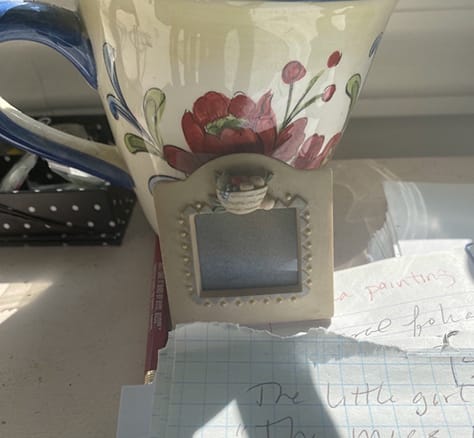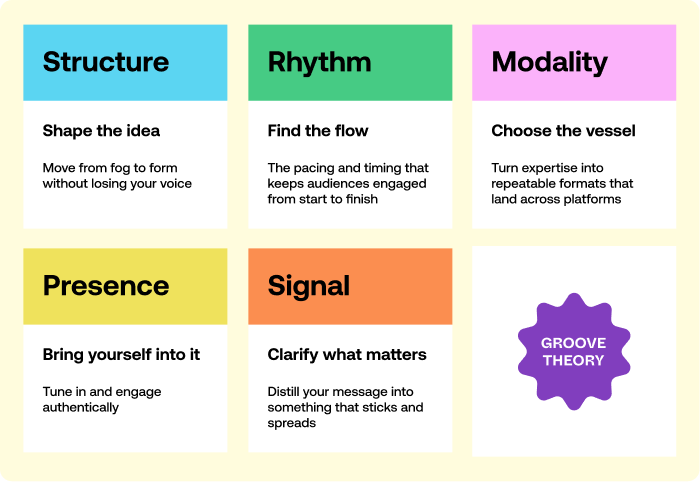Groove Theory #11 - The One-Inch Picture Frame
I'm your host, Howard Gray, founder of Wavetable - the experiential learning studio.
Currently: designing a live demo / keynote hybrid on new adventures in AI; marveling at the endurance of London pub culture
Anne Lamott keeps a one-inch picture frame on her desk.
Not as decoration. As a tool.
Lamott is a Bay Area author who's been writing for decades - novels, memoirs, essays. Mixing progressive faith with raw honesty about addiction, single motherhood and the chaos of making art, her book Bird by Bird became a bible for writers stuck at the starting line.
But even now, when she sits down and the panic sets in - the essay too sprawling, the blank page too blank - she picks up that tiny frame. She holds it up to the world and looks through it.
"All I have to do is write what I can see through this," she tells herself.
Not the whole essay. Not even a paragraph. Just what fits in that one-inch square. A memory of her father's hands. The pattern on a dress. The sound of rain on a particular afternoon.
She can do that. Anyone can.
The Tension
Lamott's brother was ten years old, sitting at the kitchen table in tears. A school report on birds was due the next morning. Three months to work on it, he hadn't started. The unopened books surrounded him like accusations.
Their father sat down next to him, put his arm around him, and said: "Bird by bird, buddy. Just take it bird by bird."
That moment stuck. She'd felt that same paralysis countless times - the gap between knowing what the finished thing should be and having no idea how to start. So she made the advice literal. Bought the frame. Put it on her desk.

Step Into It
Think about the last big project you faced. Maybe it's happening right now.
You open the document. Cursor blinks.
Where do you start? The framework? The hook? The three core principles?
You try one approach, delete it, try another. An hour passes. You've written 100 words and hated all of them. The whole thing still feels impossible.
So you close the laptop and tell yourself you'll come back when you're clearer. Except clarity doesn't arrive.
(I should know. I just did this.)
The Groove: Structure
Structure → Shape the idea without losing yourself in it.
The one-inch frame does something sneaky to your brain. It removes the pressure of the whole.
You're not building a house. You're describing a doorknob. Can you describe a doorknob? Yeah, you can.
But how does this show up elsewhere? What's "one inch" when you're not writing?
Last week, pushing myself to create a new 60 second cold open video, I limited myself to one prompt. Used an AI tool to generate just one image that fitted. The rest structured itself around that.

One inch changes by medium. In Figma, it's one frame. On paper, one sketch. For a pitch, the opening claim. For a session, your personal intro. The scale shifts, but the principle doesn't - commit to the smallest thing you can actually build. Let that teach you what comes next.
The trick is making your frame actually one inch. Not two inches. Not "just the first section." One inch.
You sit down and do that. Then you've started.
The doorknob teaches you about the door. The door teaches you about the room. You can't see the full shape until you've built the first bit.
Structure reveals itself through the first pieces you commit to. You don't need the blueprint before you build.
1. The first inch rarely leads where you expect
You think you're building one thing, start with the piece you can see, and halfway through realise you're making something else entirely. The one-inch frame gets you moving, but it doesn't promise you'll end up where you thought.
2. The frame is your microscope, but you'll need the telescope too
Start one inch to get moving. Every few pieces, zoom out. See what's emerging. Microscope for building, telescope for shape. Switch too often, lose momentum. Stay microscoped too long, miss where it's going. More on Microscope / Telescope →

Structure is one of the five elements of Groove Theory ->
The Release
The one-inch frame works because it lets structure emerge rather than forcing you to impose it.
Most of us were taught backwards - make the outline, then fill it in. But that's not how a lot of creative work actually happens. The outline comes later, after you've built enough pieces to see what shape they want to take.
This applies to anything you're building in real-time. Conversations. Sessions. Pitches. Even AI-driven projects. The structure IS the thinking, not separate from it. You discover what you're making by making it, one inch at a time.
Inch by inch, frame by frame, bird by bird.
Got a project that feels impossible? Try the one-inch frame.
Howard
Extended Mix: Tiny Frames
- Hemingway, hungover in Paris: Write one true sentence, the truest sentence you know. Even the hard-living, hard-drinking Papa needed the one-inch frame.
- Mind the Gap: Ira Glass spent seven years making radio stories he knew were terrible. His taste outpaced his skills, and that gap was agonizing. His advice: if your work disappoints you, that's normal. The only way through is volume.
- Oblique Strategies: Brian Eno's deck of constraint cards for breaking creative blocks - "What would your closest friend do?"; "Use an old idea." - forces you into a specific frame when stuck. Sidenote: I’m loving card deck creation right now.
No spam, no sharing to third party. Only you and me.

Member discussion